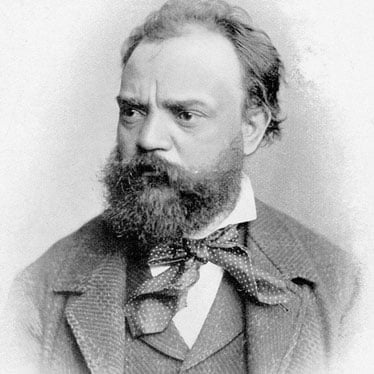Stories Behind The Greatest Classical Compositions: Dvořák’s “New World Symphony”

Officially, the “New World Symphony” is Antonin Dvořák’s Symphony No. 9 in E minor, Op. 95, B. 178, and subtitled “From the New World.” Of course, everyone simply calls it the “New World Symphony.” Dvořák composed the symphony over the first half of 1893, and it was premiered by the New York Philharmonic on December 13, 1893, at Carnegie Hall.
It was a hotly anticipated work. So much so that Carnegie Hall was forced to install a significant amount of extra seating to meet the demand for the premiere. Why so much anticipation?
At that time, Dvořák was living and working in New York City as the musical director of the National Conservatory of Music of America. The conservatory opened in 1888 with the twin aims of making music education available to talented students from every background, including marginalized communities, and to foster the creation of a particularly American national music.
Dvořák came on as musical director in 1892. As such, his work on The New World Symphony was an explicitly intentional attempt to bring an American musical sensibility to European classical music. He'd made public comments months earlier that he felt the core of an American sound could be found in Native American communities and African-American spirituals, and it was these sensibilities he'd bring to his new composition.
His comments on his influences for the symphony caused a stir, and discussions by writers and critics about what could be expected continued until the day before the premiere. In an interview with Dvořák, published by The New York Daily Herald, he reiterated that he was influenced and inspired by Native American music and black spirituals when he composed the symphony to be performed the next night.
Folk Music at the Core of a Classical Composition
Before he ever arrived in the United States, Dvořák was already well-known, particularly for his compositions incorporating Czech folk music from his native Bohemia. From a humble background, he keenly felt the struggle to maintain a cultural and political independence of his homeland from the weight of the Austro-Hungarian Empire. As such, he came to America with the approach of drawing on well-formed local folk music.
He began composing the New World Symphony in New York City but completed it during a summer excursion to Iowa, where there was a large Czech community. Thus, he got to experience a range of American vistas as he wrote, often inspired by America's wide-open spaces.
Dvořák also studied music that originated in the African-American community. He heard a student singing spirituals at the Conservatory and asked him to sing some more. Quickly, Dvořák and his student Henry Burleigh (soon to be a composer himself) were meeting regularly, with Burleigh teaching Dvořák all he had learned growing-up hearing his mother, a freed slave, sing. In his personal notes, Burleigh wrote that Dvořák had described the spiritual “Go Down Moses” as great as any theme composed by Beethoven.
The New World Symphony is noted for using elements characteristic of slave spirituals, including syncopated rhythms, pentatonic scales, and flatted seventh. It’s been debated whether Dvořák derived from specific songs in the New World Symphony. For his part, Dvořák said he was inspired by the music without directly using specific melodies. Yet many, including Burleigh, couldn’t help but hear echoes of “Swing Low, Sweet Chariot” in the second theme of the first movement.
On a more abstract level, Dvořák was also inspired by Longfellow’s poem “Song of Hiawatha.” According to Dvořák’s sketch notes and public comments, the symphony’s second movement, the Largo, was inspired by Hiawatha’s journey across the American plains with his wife, Minnehaha. The third movement, a Scherzo, was animated by the feasting and energetic dancing of the magician Pau-Puk-Keewis during the wedding scene of the epic. Indeed, he had thought to use these movements as the basis for a full-scale vocal work of Longfellow’s poem.
Impact of The New World Symphony
The work was a huge success. At the premiere, the audience applauded so loudly between each movement that Dvořák stood to bow before the orchestra could continue. It had its first European premiere less than a year later, performed by the London Philharmonic Society on June 21, 1894. It was premiered in Prague and other Czech cities later in 1894. From there, it’s remained a favorite all over the world.
The New York Philharmonic celebrated the symphony’s 175th anniversary with the performance linked in the opening paragraph, and by starting the New World Initiative, a competition for artists to create new works inspired by the New World Symphony. You can find the winners and performances here.
The work has been so closely associated with African-American spirituals, that many believed that Dvořák used the popular folk song “Goin’ Home” in the Largo. In fact, it was the symphony’s Largo movement that inspired “Goin’ Home,” which wasn’t written until 1922. You can listen to the legendary Paul Robeson sing it here.
Interestingly, Neil Armstrong brought a recording of the symphony with him during the Apollo 11 mission to the Moon.
The Melting Pot Symphony
While inspired by local musical and folk traditions, Dvořák remained firmly in the European classical tradition for its structure. The symphony is made up of four movements and built on a framework of developing and repeating themes.
Leonard Bernstein, in a lecture deconstructing the work, identified themes with Czech, French, German, Scottish and Chinese origins. Indeed, music critic James Huneker, in his review of the symphony’s premiere, described it as “distinctly American,” exactly because it was made up of so many elements representing the diverse American culture.
Photo of Antonin Dvorak courtesy of the Gallica Digital Library


